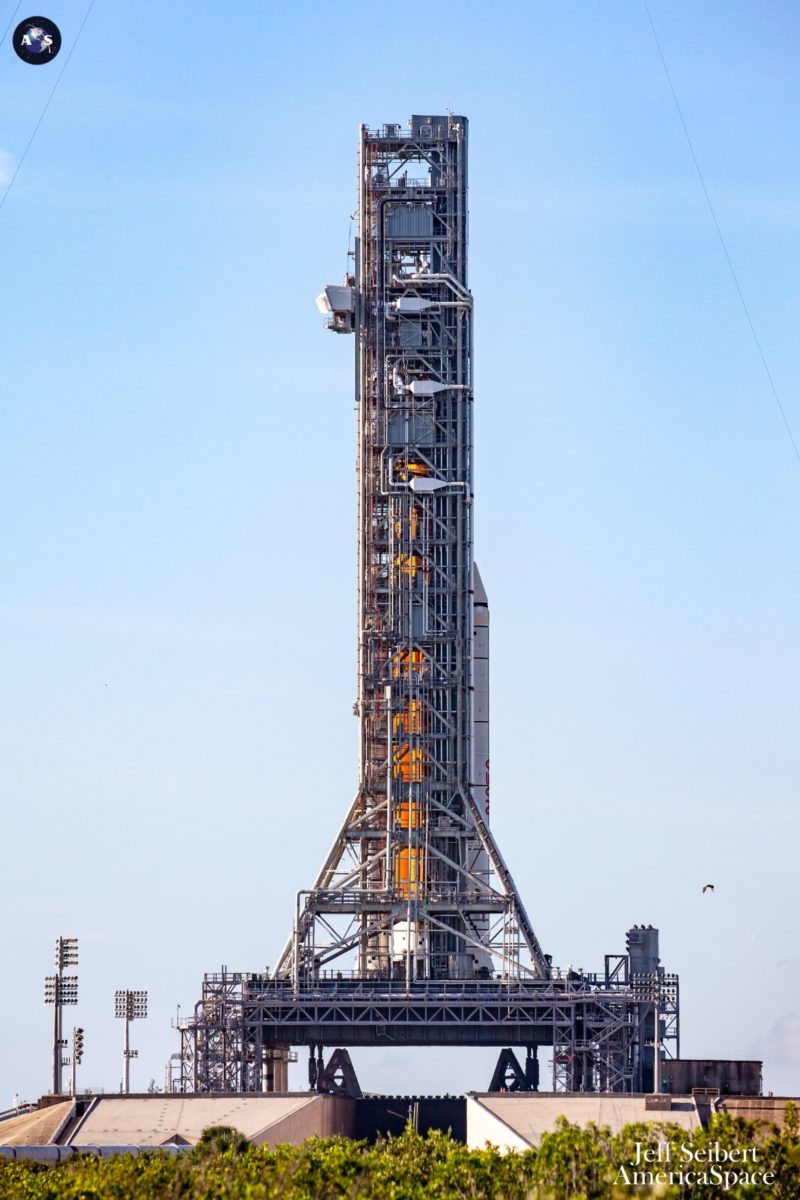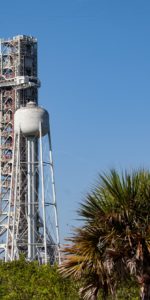
Florida’s notorious weather may yet take a step in the right direction for the opening launch attempt of the Artemis I mission tomorrow morning. According to the 45th Weather Squadron at Patrick Space Force Base, there is now an 80-percent likelihood of Mother Nature playing ball at the 8:33 a.m. EDT start of the two-hour “launch window”. But conditions could deteriorate sharply to just 60-percent-favorable if T-0 slips towards 10 a.m. EDT or the very end of the window.

“Overnight, lingering remnant showers over the peninsula may spread back to the coast, but most should dissipate just after midnight,” the 45th noted in its L-1 update on Sunday morning. “The southeasterly flow regime will remain in place for the opening of the initial launch window Monday morning.
“While the overall lightning threat seems low, onshore flow will promote scattered showers across the Atlantic waters through the launch window, with the risks lowest at the opening of the window and highest at the end.” Potential factors affecting Monday’s launch attempt include violations of the Cumulus Cloud Rule, the Surface Electric Fields Rule and the Flight Through Precipitation.

At an Artemis I countdown briefing on Sunday, NASA Test Director (NTD) Jeff Spalding and Launch Weather Officer Melody Lovin described a very clean vehicle out on historic Pad 39B at the Kennedy Space Center (KSC) in Florida and the impact of the weather upon final launch preparations.
Artemis I Launch Director Charlie Blackwell-Thompson performed the formal “Call to Stations” of her team in the Rocco A. Petrone Launch Control Center (LCC) at KSC at 9:53 a.m. EDT Saturday and countdown clocks started rolling at L-46 hours at 10:23 a.m. EDT. During the remainder of the day and last night, the Orion spacecraft and Space Launch System (SLS) hardware were powered up and checked out.
Yesterday afternoon, between 1:14 p.m. EDT and 1:16 p.m. EDT, the pad’s 600-foot-tall (200-meter) lightning protection system towers sustained three strikes in relatively quick succession; Tower 1 took a single strike, whilst Tower 2 received a pair of strikes. In his remarks earlier today, Mr. Spalding explained that the severity of the strikes has been evaluated and did not pass the minimum magnitude threshold to damage the vehicle or require action from pad teams.
The 322-foot-tall (98-meter) Artemis I stack, which has been sitting out at Pad 39B since 17 August, “looks very good from a vehicle perspective,” said Mr. Spalding, as engineers prepare to load the Core Stage and Interim Cryogenic Propulsion Stage (ICPS) with liquid oxygen and hydrogen propellants overnight. The pad is expected to be cleared of all non-essential personnel at 8:30 p.m. EDT Sunday, ahead of loading more than 733,000 gallons (3.3 million liters) of cryogens aboard the rocket.

The first of two built-in “holds” in the countdown will occur at 10:53 p.m. EDT, ahead of tanking, and has been extended in length from 90 minutes to 150 minutes to hedge against unforeseen technical issues. By 11:53 p.m. EDT, the Artemis I launch team expects to give a “Go” for cryogenic tanking and requisite valve configurations will be established to allow this process to begin.
According to Ms. Lovin, there needs to be a lower than 20-percent probability of lightning for tanking to begin. Liquid oxygen will be loaded into the tanks of the 212-foot-tall (64.6-meter) Core Stage, followed about 90 minutes later by liquid hydrogen.

Attention will then turn to ICPS tanking. The process will continue through the night and the SLS is expected to be in “replenish” mode around 6 a.m. EDT Monday.
A final built-in hold, lasting 30 minutes, is set for 7:53 a.m. EDT. Assuming clocks are released to resume counting at 8:23 a.m. EDT, this is expected to produce at T-0 point at precisely 8:33:00 a.m. EDT. The four shuttle-heritage RS-25 engines of the Core Stage will begin their ignition sequence at T-6.8 seconds, ramping up to full power in a “staggered-start” regime at roughly 200-millisecond intervals, to reach a maximum thrust of over 1.6 million pounds (730,000 kilograms).

At T-0, Northrop Grumman Corp.’s pair of five-segment Solid Rocket Boosters (SRBs) will be commanded to fire, generating a combined 7.2 million pounds (3.2 million kilograms) to push the 5.7-million-pound (2.6-million-kilogram) SLS off the pad with a total of 8.8 million pounds (3.9 million kilograms). That represents a liftoff thrust some 1.1 million pounds (500,000 kilograms) greater even than the mighty Saturn V, which sent nine crews of Apollo astronauts to the Moon between December 1968 and December 1972 and until tomorrow remains the most powerful rocket ever brought to operational status.
In some ways, this launch architecture is not unlike that of the Shuttle, with the SLS performing a “roll program” maneuver at seven seconds after liftoff to enter a “heads-down” orientation for Orion. Pummeling the ears and the soles of the feet of spectators, she will head downrange, going supersonic at 54 seconds and passing the point of maximum aerodynamic turbulence on her airframe—known colloquially as “Max Q”—at 70 seconds.
In another feature not unlike the Shuttle, the twin SRBs will expend their propellant and be jettisoned from the stack at two minutes and 12 seconds. By this stage, the vehicle will be racing towards orbit at 3,170 miles per hour (5,100 kilometers per hour) at an altitude of 29.9 miles (48 kilometers). The boosters will parachute to an Atlantic Ocean splashdown, with water impact expected about 5.5 minutes after launch.
A minute later, protective panels surrounding Orion’s European Service Module (ESM) will be jettisoned—exposing its stowed solar arrays—and at three minutes and 30 seconds the Launch Abort System (LAS) will be discarded to expose the Crew Module (CM) to the space environment for the first time. By now, the stack will be traveling at over 4,500 miles per hour (7,200 kilometers per hour) at an altitude of 54.4 miles (87.6 kilometers).

The four RS-25 engines of the Core Stage will continue to burn hot and hard after the departure of the boosters. They will finally burn out at Main Engine Cutoff (MECO), which is targeted for eight minutes and 20 seconds into the flight, at a velocity of 17,430 miles per hour (28,000 kilometers per hour) and an altitude of 100.6 miles (161.9 kilometers). By now, the stack will have shed much of its liftoff mass and will weigh just 400,000 pounds (180,000 kilograms) at MECO.
Ten seconds or so after MECO, the Core Stage will separate, leaving the ICPS/Orion combo alone. The spent Core Stage will impact the Pacific Ocean, somewhere between Hawaii and the West Coast of the United States, about 106 minutes after launch.
Orion’s solar arrays will begin to deploy some 18 minutes after launch and should be secured in place within 12 minutes. It will then be the task of the 45-foot-tall (13.7-meter) ICPS and its powerful RL-10 engine to commit a pair of critical “burns” to firstly raise the “low-point” (or perigee) of Orion’s orbit from 18.4 miles (29.6 kilometers) to 115 miles (185.2 kilometers) and secondly to send the spacecraft out of Earth’s gravitational well and onto a course for the Moon.
The Perigee Raise Maneuver (PRM) is targeted to occur about 51 minutes after tomorrow morning’s launch. But it will be the Translunar Injection (TLI) burn—set to begin about 97 minutes into the flight and see the RL-10 engine fire for 18-20 minutes—which is sure to capture the public’s imagination. If successful, it will send a crew-capable spacecraft out of low-Earth orbit and towards the Moon for the first time in almost five decades.

When Orion and the ICPS part company a little over two hours after tomorrow’s launch, they will be traveling at 19,625 miles per hour (31,580 kilometers) at an altitude of 2,300 miles (3,700 kilometers). This will commit Orion to her 42-day mission, which will see her spend almost two weeks in a Distant Retrograde Orbit (DRO) around the Moon.
Extensive systems and hardware testing will be conducted during those six weeks to validate the performance of the spacecraft in the high-radiation environment of cislunar space to carry humans on Artemis II in the second half of 2024. Assuming an on-time launch tomorrow, Orion will return to Earth on 10 October, plunging into the atmosphere at 25,000 miles per hour (40,000 kilometers per hour) to splash down in the Pacific within a broad patch of ocean running from San Diego to Hawaii to Mexico’s west coast.
FOLLOW AmericaSpace on Facebook and Twitter!
Missions » SLS » Missions » SLS » Artemis »





One Comment
One Ping
Pingback:Artemis I Scrubs, Teams Realign for Next Attempt NET Friday - AmericaSpace